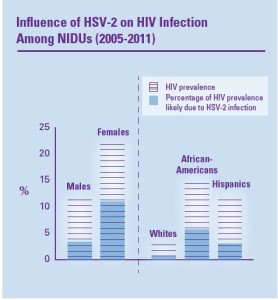Studies were undertaken to examine the influence of herpes simplex virus 2 (HSV-2) as a contributing factor in: (a) the increase in HIV among non-injecting drug users (NIDUs) (users of heroin and cocaine), and (b) the sexual and race/ethnic disparities in HIV infection among NIDUs (HIV was higher among women and among minorities).
NIDUs entering Beth Israel drug detoxification programs and methadone maintenance programs, who reported never injecting drugs, were recruited in 1995-99 and 2005-11. Results are from structured questionnaires and blood samples tested for HIV and HSV-2.
- HIV infection among NIDUs doubled from 1995-1999 to 2005-11, increasing from 7% to 13%.
- HSV-2 /HIV co-infection was common in both time periods, and the increase in HIV prevalence was mainly an increase in HSV-2/HIV co-infection.

- Analysis based on the group recruited in 2005-11 found that females had higher HIV prevalence than males (22% vs 12%) and African Americans had the highest prevalence (15%) compared with Hispanics (12%) and Whites (3%).
- Sex and race/ethnic differences in HSV-2 followed the same pattern found in HIV, and disparities in HIV infection were greatly reduced when taking into account the increased biological susceptibility to HIV due to HSV-2 infection. For females, about half of the HIV infections (50%) were attributed to being HSV-2 positive; and for African Americans, more than one-third (38%) was attributed to HSV-2.
- The findings clearly indicate that interventions to reduce the transmission of HIV due to HSV-2 infection are needed.
- Rather than a single intervention, a combination prevention program would be much more effective, and should include: Pre-exposure prophylaxis (PrEP) for HIV-/HSV-2+ individuals and HIV treatment for HIV+ individuals (treatment as prevention); social marketing programs encouraging condom use; drug treatment programs; and behavioral sexual
risk-reduction programs for NIDUs. - While HSV-2 suppressive therapy has not been found to be effective in reducing the transmission of HIV to date, additional research on HSV-2 suppressive therapy is warranted, including examining higher doses of
HSV-2 antivirals.
Des Jarlais DC, Arasteh K, McKnight C, Perlman DC, Cooper HLF (2013).
HSV-2 infection as a cause of female/male and racial/ethnic disparities in HIV infection
PLOS One, 8 (6), e66874. doi: 10.1371/journal.pone.0066874. PMCID: PMC3688945. Download PDF.
Des Jarlais DC, Arasteh K, McKnight C, Perlman DC, Feelemyer J, Hagan H, Cooper HL (2014).
HSV-2 co-infection as a driver of HIV transmission among heterosexual non-injecting drug users in New York City
PLOS One, 9 (1), e87993. doi: 10.1371/journal.pone.0087993. PMCID: PMC3909306. Download PDF.
Or contact Don Des Jarlais: DDesJarlais@chpnet.org
This project was supported by a grant from the National Institute on Drug Abuse [R01 DA003574].
